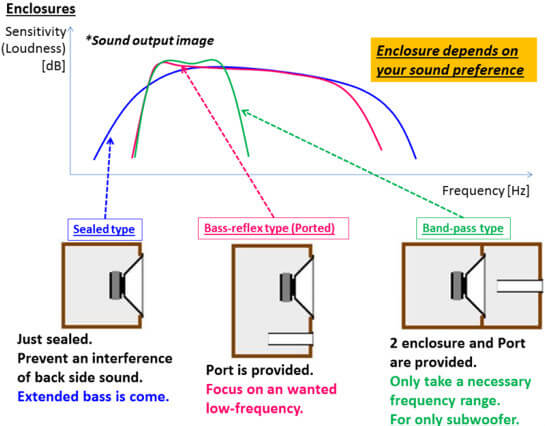Table Of Content
- How to Choose the Best Ported Subwoofer Box Design
- For space
- Which type of subwoofer box design is ideal for achieving the deepest bass?
- Q: Does the Material Making the Subwoofer Enclosure Affect Bass Reproduction?
- Air Space and Bass Response:
- Kickstarting Your Project: Crafting a Basic Subwoofer Enclosure
- Q Power Single Side Ported Speaker Box

In conclusion, speaker box design is an important factor when considering what type of speaker to use. Depending on your application, the type of enclosure and size will play a crucial role in achieving optimal sound performance from your speaker. Free-air enclosures entail a woofer mounted on a board and then attached to the rear deck or a trunk against the rear seat. The trunk, in that case, would act as the enclosure, isolating the low frequencies from the back of the vehicle.
How to Choose the Best Ported Subwoofer Box Design
You can choose a suitable enclosure from the existing ones, or make your own subwoofer box design. First, you’ll need to find a suitable place to mount your bass subwoofer enclosure. Ensure the mounting surface is strong enough to support the weight of the enclosure and its level. You’ll also want to ensure you have enough room around the enclosure so that you won’t have any issues with ventilation or clearance. Different types of enclosures come in different sizes and shapes, so depending on where you plan to place your speakers, look for a size and shape that will fit your space. A speaker bandpass enclosure, also called a “fourth-order bandpass” enclosure, is designed to maximise the transfer of energy from a speaker driver to the air.
The art of speaker design, explained by a master - CNET
The art of speaker design, explained by a master.
Posted: Sat, 24 Mar 2018 07:00:00 GMT [source]
For space
This is a smooth gradual roll off that gives them a very good response curve and will not have an excessive peaks in output at certain frequencies. Passive radiators can be used in place of ports in a bass-reflex design, especially when space constraints prevent using an adequately sized port. A passive radiator is essentially a driver without a voice coil and magnet, tuned to vibrate at specific frequencies. Building your subwoofer box is as much about the journey as the final product. It's a testament to the power of DIY, showcasing how a combination of technical knowledge, creativity, and dedication can lead to remarkable results. The accuracy of your cut lines is paramount to the success of your project.
Which type of subwoofer box design is ideal for achieving the deepest bass?
Monitor Audio Anthra W15 Subwoofer Review - StereoNET UK
Monitor Audio Anthra W15 Subwoofer Review.
Posted: Wed, 24 Jan 2024 08:00:00 GMT [source]
Sketching out your design with these factors will guide you in creating an enclosure that meets your sound quality expectations and aesthetic preferences. Choosing the correct bass subwoofer box dimensions is essential for achieving your system’s best bass and sound quality. While the manufacturer usually specifies the ideal dimension for a given subwoofer, you can also use a subwoofer box design calculator to customize the optimal box size.
Q: Does the Material Making the Subwoofer Enclosure Affect Bass Reproduction?
A well-designed box tailored to your subwoofer's specifications and your listening preferences can dramatically enhance your audio system's bass performance. In an isobaric enclosure, two subwoofers are coupled together to produce double the power of one subwoofer. It is actually possible to achieve the same bass with an Isobaric enclosure as you would with a sealed enclosure of twice the size. Transmission line enclosures have several advantages over other types of enclosures. The long duct allows sound energy to travel further, resulting in more bass output than a standard sealed or ported box. To make this task easier, we recommend you use the best free subwoofer box design software available on the market today.
Air Space and Bass Response:
From the head unit performance to the size of the box, as well as the frequency response and power of the subwoofer and amplifier, all of these factors need to be considered. After resonance frequency is achieved, the response is degraded with a steep roll-off of 24 db / octave. The vent, if not designed correctly or at high sound levels, can get noisy, as the air escapes the port. This can help you make the best free subwoofer box design software that you can find on the internet today, allowing you to save hundreds of dollars over the custom-built options that are available.
I love the fact that this tool invites you to input parameters such as the speaker’s dimensions, internal volume, and port details (including port dimensions and port length). We audiophiles know the worth of having a good sub enclosure design to create an ultimate sound and bass experience. The Displacement Calculator is a best guess to the displacement of the speaker driver. Magnet height is not provided, so we measured a value of 30mm assuming this drawing is to scale.If we had the drivers in hand, then we could measure them to be sure. We also need to indicate that we will be flush mounting the driver and using 3/4" thick lumber in our enclosure. To keep this example interesting,I am going to ignore these results and use one sealed enclosure and one ported enclosure to show the differences between the two.

It’s also fitted with premium push terminals complete with speaker wires. With that, this subwoofer box is ready to use straight from the package. However, I wish that they had made the wires long for easier installation. To ensure that this ported subwoofer box is made to last, it’s also equipped with pneumatically applied brad nails. This holds the MDF parts tightly together, so there would be no leak even on changing temperature and weather. Based on the airspace calculation, plan the internal dimensions of the enclosure, considering the subwoofer's requirements.
It's essential to select the correct size box based on the specifications of your subwoofer and the available space in your vehicle. Achieving the correct box size is essential for maximizing bass response, ensuring the subwoofer operates efficiently, and delivering the desired audio experience. Regarding subwoofer box design, it's essential to understand the basic principles. A subwoofer enclosure, also known as a box, is critical in delivering your subwoofer's best possible bass response.
Aside from that, this box has screw-down terminal cups to prevent leaks. It’s also made for high-power subwoofers and guaranteed to deliver hard-hitting low frequencies. And since building your own subwoofer box can be tricky, many manufacturers are now selling their designs commercially. This enclosure doesn’t cancel the low frequency that emanates from the speaker. Also, it protects the subwoofer drivers from potential damage, much so if the unit is being transported regularly.
Mike's interest in subwoofers began at a young age when he started messing around with the ones his dad had in his home theater system. When he's not doing that, he's usually spending time with his family or tinkering with new ways to improve his home theater setup. Moreover, it undertakes evaluations of ports, bracing, and working volume, providing an in-depth understanding of your design. I frequently use the Loudspeaker Design Calculations Toolkit (LDCT), a powerful, open-source software that provides diverse calculations essential to loudspeaker design. Again, we don't have the woofer driver displacement, so we will use our calculator to estimate it.Here is the ScanSpeak diagram.
Also, all of the joints and walls in a speaker enclosure should be airtight, including screw holes and wire holes. Any leaks or flexing will cause cancellation, resulting in reduced output. The other advantage of mounting woofers face to face or magnet to magnet, it will smooth out the non-linearity properties of a speaker. With older speaker designs, the pushing force was sometimes not as strong as the pulling force. This created distortion because it would not accurately reproduce the signal the speaker received. Isobaric helped reduce this distortion but with today’s technology, it is no longer necessary.
One thing that buyers mention is that this ported subwoofer box design doesn’t have insulation. Other than that, it remains good for the money, especially if you want a durable box for your woofers. Overall, this subwoofer box design has a 5.5” mounting depth and 11.125” sub-cut-out.
These genres of music usually have a good amount of drums in the recording and do not have a lot of very deep bass information in the recordings. BassBox Pro is a premium software and more suitable for professionals. However, I found this program an all-in-one solution for designing both sealed and ported boxes. Choosing the right box design for your subwoofer depends on your preferences, the sound quality you desire, and the specifications of your subwoofer. It's essential to consider the pros and cons of each design to make an informed decision for your build.

No comments:
Post a Comment